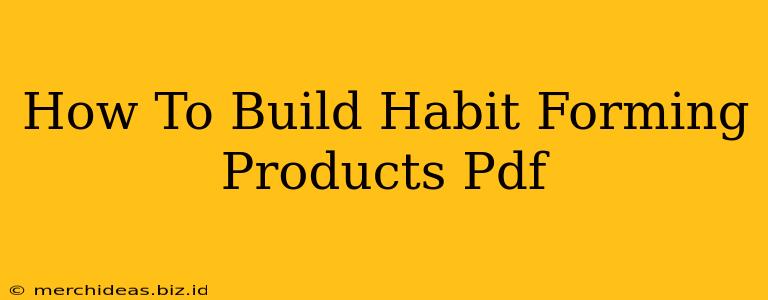How To Build Habit-Forming Products: A Comprehensive Guide
Building a product that users not only enjoy but actively integrate into their daily lives—a habit-forming product—is the holy grail for many businesses. This isn't about creating an addiction; it's about designing an experience so valuable and engaging that users naturally incorporate it into their routines. This guide will walk you through the key principles and strategies to achieve this.
Understanding the Hook Model
Nir Eyal's Hook Model is a cornerstone of habit formation. It outlines a four-step process that keeps users coming back for more:
-
Trigger: This is what prompts the user to engage with your product. Triggers can be external (e.g., a notification, email, or social media post) or internal (e.g., boredom, loneliness, or a specific need). Understanding your user's needs and motivations is crucial here. Identifying the internal triggers that drive their behavior will allow you to design more effective external triggers.
-
Action: This is the simplest behavior you want users to perform within your product. It should be easy, requiring minimal effort and friction. The goal is to make the initial engagement as painless as possible.
-
Variable Reward: This keeps users engaged by providing unpredictable rewards. This doesn't necessarily mean monetary rewards; it can be anything that provides a sense of satisfaction, accomplishment, or surprise—think unlocking new levels in a game or discovering unexpected content. The key is to make the reward unpredictable and keep users wanting more.
-
Investment: This is the step where users put something into your product, strengthening their commitment. This could be creating a profile, adding content, inviting friends, or providing feedback. The more invested users become, the more likely they are to return. This investment increases the cost of switching to a competitor.
Key Strategies for Habit Formation
Beyond the Hook Model, several other strategies can significantly boost habit formation:
-
Simplify User Onboarding: A smooth onboarding experience ensures users quickly grasp your product's value proposition and begin using it. Avoid overwhelming users with too much information upfront; focus on providing a clear path to their first valuable action.
-
Personalization and Customization: Tailoring the user experience to individual preferences increases engagement and satisfaction. Recommendations, personalized content feeds, and adjustable settings all contribute to this. Data-driven personalization is key here.
-
Community Building: Fostering a sense of community around your product creates loyalty and engagement. Features like forums, comment sections, and social sharing mechanisms can greatly enhance this.
-
Gamification: Incorporating game mechanics, such as points, badges, and leaderboards, can incentivize continued usage and encourage healthy competition. Gamification can make even mundane tasks more engaging.
-
Regular Updates and New Content: Keeping your product fresh and exciting is essential for sustained user engagement. Regular updates with new features, content, and improvements will keep users coming back for more.
-
Data Analysis and Iteration: Constantly analyze user behavior to identify patterns and areas for improvement. A/B testing and user feedback are invaluable for refining your product and enhancing its habit-forming qualities.
Measuring Success
Tracking key metrics is crucial to assess the effectiveness of your habit-formation strategies. Consider tracking metrics such as:
- Daily/Monthly Active Users (DAU/MAU): Indicates how frequently users engage with your product.
- Retention Rate: Measures the percentage of users who continue using your product over time.
- Session Duration: Shows how long users spend within your product each session.
- Customer Lifetime Value (CLTV): Indicates the long-term value of each user to your business.
By understanding the Hook Model, implementing effective strategies, and tracking relevant metrics, you can significantly increase the chances of building a truly habit-forming product—one that users not only love but actively incorporate into their daily lives. Remember, building a habit-forming product is a continuous process of iteration and refinement. Stay tuned to user feedback and adapt your strategies accordingly.
